Communication should be:
(a) From Top to Bottom level
(b) From Bottom to top
(c) 2 way
(d) None of these
Answer: c
Which ethical approach is guided by what will result in the greatest good for the greatest number of people?
(a) Moral-Rights approach
(b) Individual approach
(c) Utilitarian approach
(d) Justice approach
Answer: d
Low level management has a complete authority to make decisions in case of:
(a) Centralization
(b) Decentralization
(c) Scalar Chain
(d) Order
Answer: b
Which one of the following individuals is most closely associated with scientific management?
(a) Frederick Taylor
(b) Mary Parker Follett
(c) Harold Koontz
(d) Max Weber
Answer: a
Each subordinate should report to one and only one superior is called:
(a) Authority
(b) Unity of command
(c) Unity of direction
(d) Order
Answer: b
Check Also: Financial Planning & Financial Management MCQs | for FPSC Senior Auditor Posts
When managers give goals to employees, they must always:
(a) Use employee-recognition as a reward
(b) Provide feedback to the employees
(c) Let the employees participate in setting the goals
(d) All of the given options
Answer: d
The organization that has developed the capacity to continuously learn, adapt, and change is called:
(a) Virtual organization
(b) Learning organization
(c) Traditional organization
(d) Bureaucratic organization
Answer: b
Your firm’s attorney has which of the following power when giving legal advice?
(a) Legitimate
(b) Status
(c) Expert
(d) Coercive
Answer: c
Which of the following is a function of how much decision-making authority is pushed down to lower levels in the organization?
(a) Departmentalization
(b) Centralization
(c) Span of control
(d) Power
Answer: a
Which of the management tasks is the most important for a supervisory manager?
(a) Planning
(b) Organizing
(c) Controlling
(d) Staffing
Answer: c
A budget is an example of which of the following plan?
(a) Strategic plan
(b) Single use plan
(c) Informal plan
(d) Standing plan
Answer: b
The plans which deal with fairly small set of activities are called:
(a) Strategic plan
(b) Tactical plan
(c) Operational plan
(d) Personal plan
Answer: d
A budget is an example of which of the following plan?
(a) Strategic plan
(b) Single use plan
(c) Informal plan
(d) Standing plan
Answer: b
Which of the following can be defined as the art and science of formulating, implementing and evaluating cross-functional decisions that enable an organization to achieve its objectives?
(a) Strategy formulation
(b) Strategy evaluation
(c) Strategy implementation
(d) Strategic management
Answer: d
Which of the following is NOT one of the situational factors thought to influence the relationship between leader behavior and subordinate motivation to perform in the path-goal theory?
(a) Preferences of the leader
(b) Subordinate locus of control
(c) Characteristics of the work group
(d) Task structure
Answer: d
Social obligation is the obligation of a business to meet its:
(a) Social and technological responsibilities
(b) Economic and social responsibilities
(c) Technological and economic responsibilities
(d) Economic and legal responsibilities
Answer: d
Check Also: Accountability VS Good Governance | CSS Times Video Lectures
All of the following are the examples of the actions that can be taken in strategy implementation stage EXCEPT:
(a) Changing organization’s pricing strategy
(b) Developing new employee benefits
(c) Transferring managers among divisions
(d) Taking corrective action when needed
Answer: a
The method by which strategies are operational zed or executed within the organization is called:
(a) Strategy implementation
(b) Strategy evaluation
(c) Strategy formulation
(d) Strategy imitation
Answer: a
Which of the following is associated with the classical view of social responsibility?
(a) Economist Robert Reich
(b) Concern for social welfare
(c) Stockholder financial return
(d) Voluntary activities
Answer: a
Which of the management tasks is the most important for a supervisory manager?
(a) Planning
(b) Organizing
(c) Controlling
(d) Staffing
Answer: c
Forecasting techniques fall into which of the following two categories?
(a) Fixed asset and human capital
(b) Predictive and confirmatory
(c) Quantitative and qualitative
(d) Empirical and conceptual
Answer: c
Which of the following theory is currently the most widely accepted when describing employee motivation?
(a) Reinforcement
(b) Three-needs
(c) Expectancy
(d) Equity
Answer: b
A leader, such as Bill Gates of Microsoft, who can inspire followers above their own self-interests and can have a profound effect on their performance, are known as which of the following?
(a) Transactional leaders
(b) Directive leaders
(c) Informational leaders
(d) Transformational leaders
Answer: b
A situation in which an organization is not implementing valuable strategies that are being implemented by competing organization is called:
(a) Competitive disadvantage
(b) Distinctive competencies
(c) Competitive edge
(d) Competitive parity
Answer: a
Which of the following term is defined as a business firm’s obligation, beyond that required by law and economics, to pursue long-term goals that are good for society?
(a) Social obligation
(b) Social responsibility
(c) Social screening
(d) Values-based management
Answer: a
Feed Back of ____ is necessary to improve the quality of the product.
(a) Customers
(b) Employees
(c) Investors
(d) All of these
Answer: a
Which of the following is the accountability for the achievement of objectives, the use of resources, and the adherence to organizational policy?
(a) Power
(b) Responsibility
(c) Authority
(d) Planning
Answer: c
Which management theory focuses on managing the total organization?
(a) Scientific management
(b) Administrative management
(c) Behavioral management
(d) Quantitative management
Answer: a
The process of monitoring performance, comparing it with goals and correcting any significant deviations is known as:
(a) Planning
(b) Organizing
(c) Leading
(d) Controlling
Answer: d
Mr. A is a Manager on XYZ company; he has a reputation for being an open and honest person and understands how to motivate employees and customers, he said to have good____________ skills.
(a) Sales
(b) Political
(c) Interpersonal
(d) Technical
Answer: c
Someone who works with and through other people by coordinating their work activities to accomplish organizational goals is called:
(a) A Very intelligent: Individual
(b) A Supervisor of Production Work
(c) A Manager
(d) An operation Supervisor
Answer: c
SWOT analysis divides organizational strength into two categories; Common strength and______
(a) Strategic imitation
(b) Competitive Parity
(c) Distinctive Competencies
(d) Threats
Answer: c
The Continues line if authority that extends from the upper level of management to the lowest levels of the organization is called:
(a) Authority line of responsibility
(b) Unity of Commerce
(c) Responsibility factor
(d) Chain of command
Answer: d
Which is the most common cause of business failure?
(a) Insufficient Capital
(b) Unstable market
(c) Insufficient experience
(d) Poor Entrepreneurship
Answer: c
Which of the following is the accountability for the achievement of objectives, the use of resources, and the adherence to organizational policy?
(a) Power
(b) Responsibility
(c) Authority
(d) Planning
Answer: c
Organizations can play role in addressing global environment issues through all of the following ways EXCEPT:
(a) Greening of Management
(b) Depletion of natural Resources
(c) Fulfilling their Social Obligation
(d) Avoiding industrial accidents
Answer: b
_______ are large scale action plans of an organization for interacting with environment in order to achieve long term goals.
(a) Objectives
(b) Strategic Goals
(c) Strategies
(d) Actions
Answer: c
Living Organisms take substances from their environment such as food and air and return other substances environment. This is an example of
(a) Close System
(b) Hybrid System
(c) Open System
(d) None of Above
Answer: c
When the strength provides superior and unique customer value and is difficult to imitate then the distinctive competence creates a sustainable______
(a) Competitive Advantage
(b) Scope
(c) Resource Deployment
(d) Effective Strategy
Answer: a
Which of the following organization is rigidly controlled and efficient?
(a) Organic
(b) Mechanistic
(c) Horizontal
(d) Learning
Answer: b
Inspiring people to be high performer is called:
(a) Controlling
(b) Leading
(c) Planning
(d) Organizing
Answer: b
All of the following are the characteristics of an organization EXCEPT:
(a) People
(b) Product
(c) Purpose
(d) Structure
Answer: b
All of the following are managerial roles identified in Mintzberg’s Model EXCEPT:
(a) Informational
(b) Interpersonal
(c) Functional
(d) Decisional
Answer: c
People with which of the following decision making style have a high tolerance for ambiguity and tend to focus on the people or social aspects of a work situation?
(a) Analytical
(b) Behavioral
(c) Directive
(d) Conceptual
Answer: d
Achieving results, making the right decisions, and successfully carrying them out to achieve an organization’s goals refer to:
(a) Efficiency
(b) Reliability
(c) Effectiveness
(d) Validity
Answer: c
What is the best term to describe the process of attempting to influence other people to attain the organization’s objectives?
(a) Planning
(b) Organizing
(c) Leading
(d) Controlling
Answer: c
Which of the following early advocates of organizational behavior was concerned about deplorable working conditions?
(a) Robert Owens
(b) Hugo Munsterberg
(c) Mary Parker Follett
(d) Chester Barnard
Answer: a
The management function that specifies goals to be achieved and deciding in advance the appropriate actions to achieve those goals is:
(a) Leading
(b) Controlling
(c) Organizing
(d) Planning
Answer: d
Which viewpoint emphasizes finding ways to manage work more efficiently?
(a) Behavioral
(b) Quantitative
(c) Classical
(d) Qualitative
Answer: c
Plant managers come under which of following management levels?
(a) First-line managers
(b) Non-managerial employees
(c) Middle managers
(d) Top managers
Answer: c

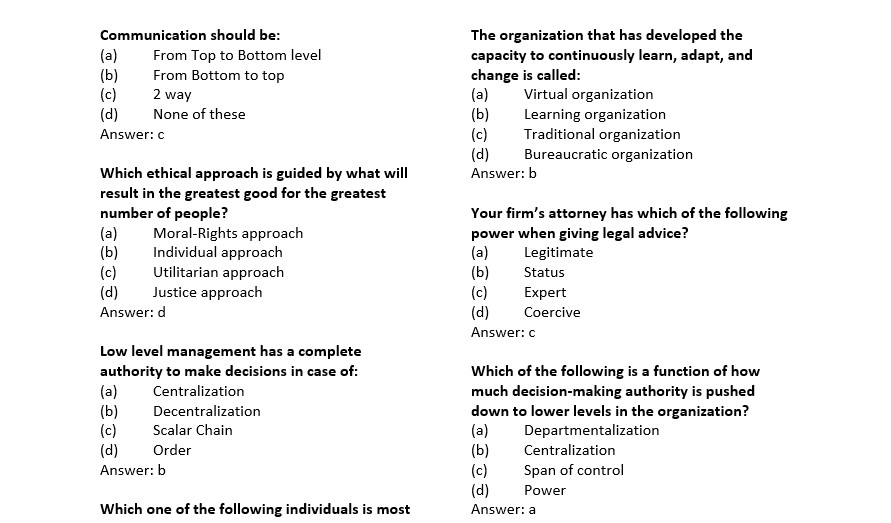

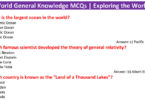
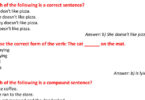
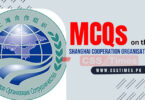
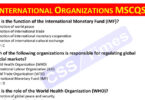
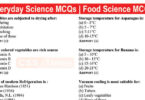
[…] Principles of Business & Financial Management MCQs […]
[…] Check Also: Principles of Business & Financial Management MCQs […]
[…] Check Also: Principles of Business & Financial Management MCQs […]